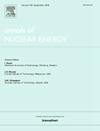基于模型模型的异构泄漏模型
IF 1.9
3区 工程技术
Q1 NUCLEAR SCIENCE & TECHNOLOGY
引用次数: 0
摘要
本文介绍了APOLLO3®代码的一些发展及其在支持工业研究中的应用。我们描述了在特征法(MOC)框架下实现非均匀泄漏模型(HLM)的一种数值技术。我们初步建立了该模型的理论框架,并澄清了我们认为重要的与其作为均质化技术使用有关的一些方面。事实上,在经典的HLM均匀化应用中,一些重要的近似是为了将复值通量转换为实值加权函数。我们建议一种在实践中避免这种近似的方法。然后介绍了一种新的用MOC求解HLM的数值方法。该方法是直接在截面上积分HLM的复值泄漏项,从而通过积分复值函数来推广MOC。此外,我们还详细介绍了使经典关键搜索算法(对经典DB2泄漏模型有效)适应新上下文所需的必要修改。数值结果支持这些发展。本文章由计算机程序翻译,如有差异,请以英文原文为准。
A MOC-based heterogeneous leakage model
This paper presents some developments of the APOLLO3code and their applications in support to industrial studies. We describe a numerical technique to implement, in the framework of the Method Of Characteristics (MOC), the Heterogeneous Leakage Model (HLM). We preliminarily set up the theoretical framework of this model and clarify some aspects related to its use as homogenization technique that we believe important. In fact in the classic use of HLM for homogenization some important approximations are made to switch from complex-valued fluxes to real-valued weighting functions. We suggest an approach to avoid such approximations in practice. Then we describe a new numerical technique to solve with the MOC the HLM. The approach consists in integrating the complex-valued leakage term of the HLM directly in the cross section, and therefore to generalize MOC by integrating a complex-valued function. Moreover we detail also the necessary modifications that are necessary to adapt the classical algorithm of critical search (valid for the classical leakage model) to the new context. Numerical results are shown in support to these developments.
求助全文
通过发布文献求助,成功后即可免费获取论文全文。
去求助
来源期刊

Annals of Nuclear Energy
工程技术-核科学技术
CiteScore
4.30
自引率
21.10%
发文量
632
审稿时长
7.3 months
期刊介绍:
Annals of Nuclear Energy provides an international medium for the communication of original research, ideas and developments in all areas of the field of nuclear energy science and technology. Its scope embraces nuclear fuel reserves, fuel cycles and cost, materials, processing, system and component technology (fission only), design and optimization, direct conversion of nuclear energy sources, environmental control, reactor physics, heat transfer and fluid dynamics, structural analysis, fuel management, future developments, nuclear fuel and safety, nuclear aerosol, neutron physics, computer technology (both software and hardware), risk assessment, radioactive waste disposal and reactor thermal hydraulics. Papers submitted to Annals need to demonstrate a clear link to nuclear power generation/nuclear engineering. Papers which deal with pure nuclear physics, pure health physics, imaging, or attenuation and shielding properties of concretes and various geological materials are not within the scope of the journal. Also, papers that deal with policy or economics are not within the scope of the journal.
 求助内容:
求助内容: 应助结果提醒方式:
应助结果提醒方式:


